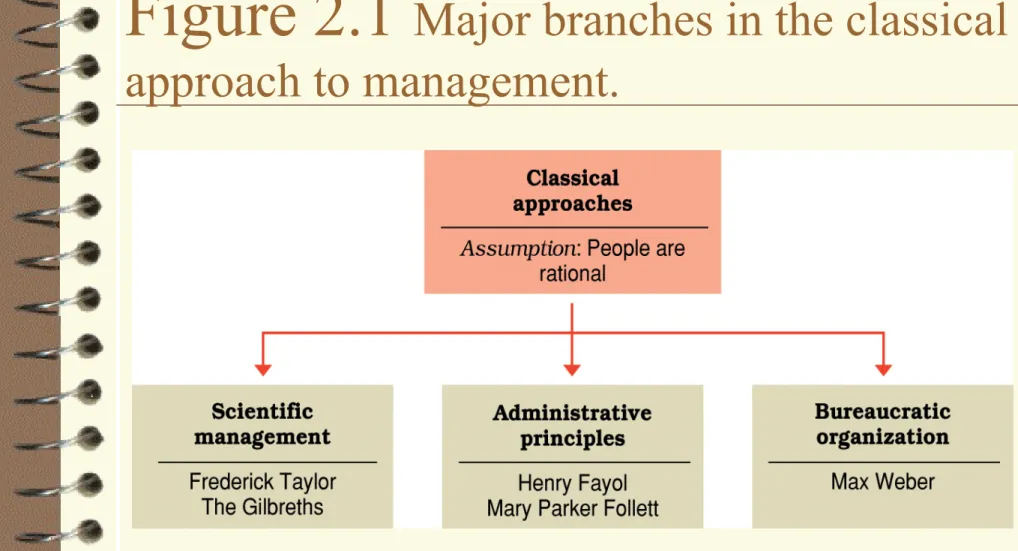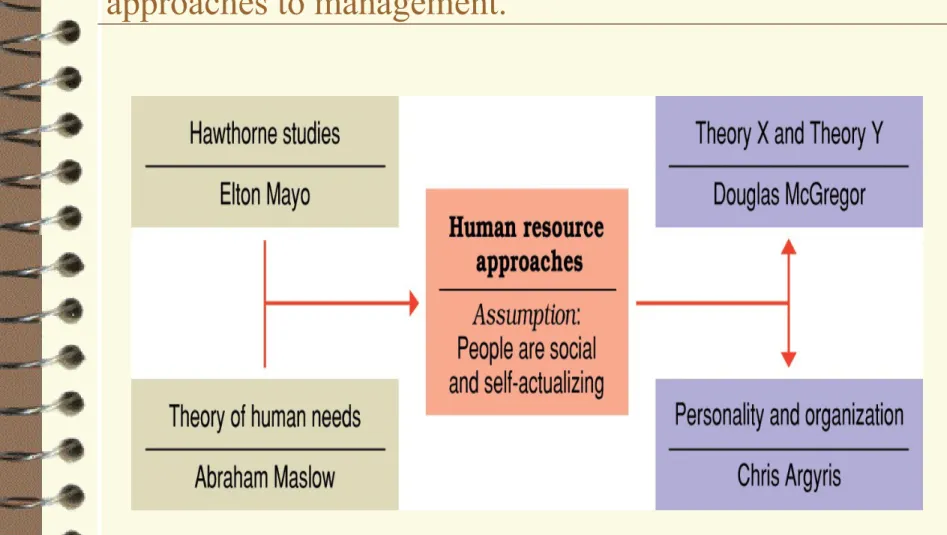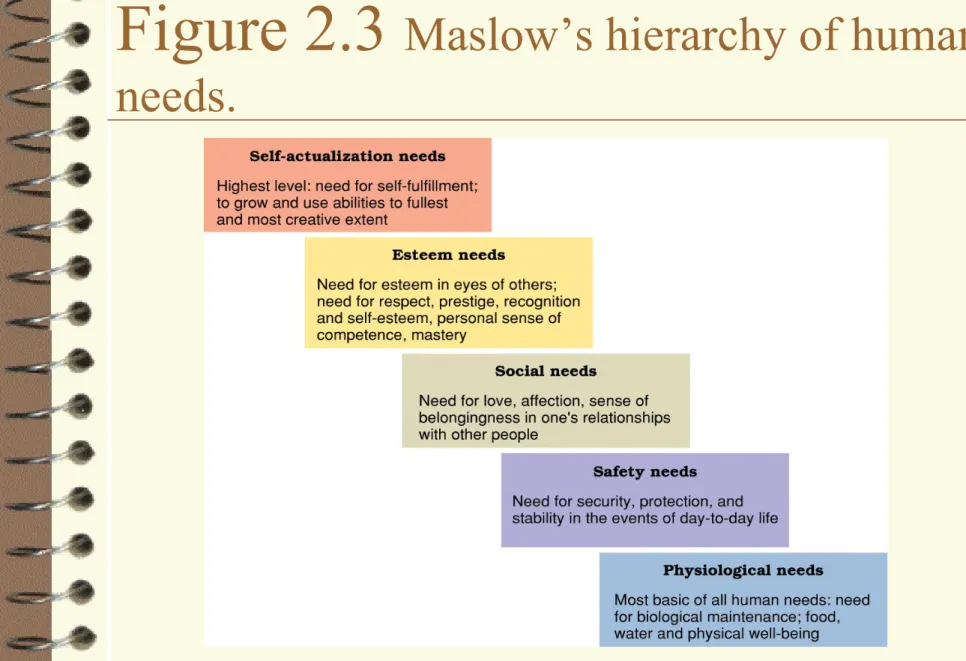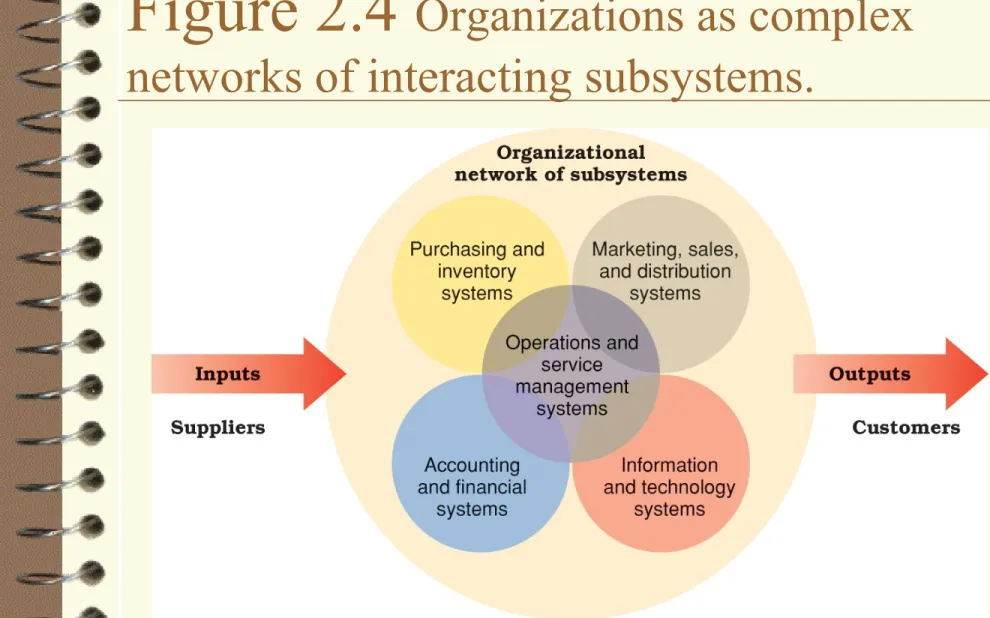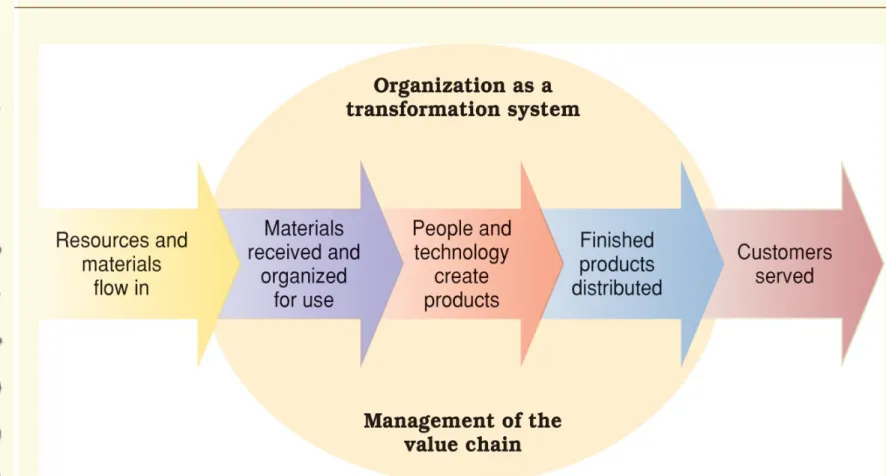PowerPoint Presentation to Accompany Chapter 2 of
Management Fundamentals
Canadian Edition
Schermerhorn Wright
Prepared by: Michael K. McCuddy Adapted by: Lynda Anstett & Lorie Guest Published by: John Wiley & Sons Canada, Ltd.
Planning Ahead — Chapter 2 Study Questions
What can be learned from classical management thinking?
What ideas were introduced by the human resource approaches?
What is the role of quantitative analysis in management?
What is unique about the systems view and contingency thinking?
What are the continuing management themes of the
21st century?
Study Question 1: What can be learned from classical management thinking?
Classical approaches to management include:
– Scientific management
– Administrative principles
– Bureaucratic organization
Figure 2.1 Major branches in the classical
approach to management.
Study Question 1: What can be learned from classical management thinking?
Scientific management (Frederick Taylor)
– Develop rules of motion, standardized work
implements, and proper working conditions for every job.
– Carefully select workers with the right abilities for the job.
– Carefully train workers and provide proper incentives.
– Support workers by carefully planning their work and removing obstacles.
Study Question 1: What can be learned from classical management thinking?
Scientific management (the Gilbreths)
– Motion study
• Science of reducing a job or task to its basic physical motions.
– Eliminating wasted motions improves
performance.
Study Question 1: What can be learned from classical management thinking?
Administrative principles (Henri Fayol) — rules of management:
– Foresight — to complete a plan of action for the future.
– Organization — to provide and mobilize resources to implement the plan.
– Command — to lead, select, and evaluate workers to get the best work toward the plan.
– Coordination — to fit diverse efforts together and ensure information is shared and problems solved.
– Control — to make sure things happen according to plan and to take necessary corrective action.
Study Question 1: What can be learned from classical management thinking?
Administrative principles (Henri Fayol) — key principles of management:
– Scalar chain — there should be a clear and unbroken line of communication from the top to the bottom of the organization.
– Unity of command — each person should receive orders from only one boss.
– Unity of direction — one person should be in charge of all activities with the same performance objective.
Study Question 1: What can be learned from classical management thinking?
Administrative principles (Mary Parker Follett)
–
Groups and human cooperation:
• Groups are mechanisms through which individuals can combine their talents for a greater good.
• Organizations are cooperating “communities” of managers and workers.
• Manager’s job is to help people in the organization cooperate and achieve an integration of interests.
Study Question 1: What can be learned from classical management thinking?
Administrative principles (Mary Parker Follett)
–
Forward-looking management insights:
• Making every employee an owner creates a sense of collective responsibility (precursor of employee
ownership, profit sharing, and gain-sharing)
• Business problems involve a variety of inter-related factors (precursor of systems thinking)
• Private profits relative to public good (precursor of managerial ethics and social responsibility)
Study Question 1: What can be learned from classical management thinking?
Bureaucratic organization (Max Weber)
– Bureaucracy
• An ideal, intentionally rational, and very efficient form of organization.
• Based on principles of logic, order, and legitimate authority.
Study Question 1: What can be learned from classical management thinking?
Characteristics of bureaucratic
organizations:
– Clear division of labor – Clear hierarchy of
authority
– Formal rules and procedures
– Impersonality
– Careers based on merit
Possible disadvantages of bureaucracy:
– Excessive paperwork or “red tape”
– Slowness in handling problems
– Rigidity in the face of shifting needs
– Resistance to change – Employee apathy
Study Question 2: What ideas were introduced by the human resource approaches?
Human resource approaches include:
–
Hawthorne studies
–
Maslow’s theory of human needs
–
McGregor’s Theory X and Theory Y
–
Argyris’s theory of adult personality
Figure 2.2
Foundations in the behavioral or human resource approaches to management.Study Question 2: What ideas were introduced by the human resource approaches?
Hawthorne studies
– Initial study examined how economic
incentives and physical conditions affected worker output.
– No consistent relationship found.
– “Psychological factors” influenced results.
Study Question 2: What ideas were introduced by the human resource approaches?
Hawthorne studies (cont.)
– Relay assembly test-room studies
• Manipulated physical work conditions to assess impact on output.
• Designed to minimize the “psychological factors” of previous experiment.
• Factors that accounted for increased productivity:
– Group atmosphere
– Participative supervision
Study Question 2: What ideas were introduced by the human resource approaches?
Hawthorne studies (cont.)
– Employee attitudes, interpersonal relations, and group processes.
• Some things satisfied some workers but not others.
• People restricted output to adhere to group norms.
– Lessons from the Hawthorne Studies:
• Social and human concerns are keys to productivity.
• Hawthorne effect — people who are singled out for special attention perform as expected.
Study Question 2: What ideas were introduced by the human resource approaches?
Maslow’s theory of human needs
– A need is a physiological or psychological
deficiency a person feels compelled to satisfy.
– Need levels:
• Physiological
• Safety
• Social
• Esteem
• Self-actualization
Figure 2.3 Maslow’s hierarchy of human
needs.
Study Question 2: What ideas were introduced by the human resource approaches?
Maslow’s theory of human needs
– Deficit principle
• A satisfied need is not a motivator of behavior.
– Progression principle
• A need becomes a motivator once the preceding lower-level need is satisfied.
– Both principles cease to operate at self-actualization level.
Study Question 2: What ideas were introduced by the human resource approaches?
McGregor’s Theory X assumes that workers:
– Dislike work – Lack ambition – Are irresponsible – Resist change – Prefer to be led
McGregor’s Theory Y assumes that workers are:
– Willing to work
– Capable of self control – Willing to accept
responsibility – Imaginative and
creative
– Capable of self- direction
Study Question 2: What ideas were introduced by the human resource approaches?
Implications of Theory X and Theory Y:
– Managers create self-fulfilling prophecies.
– Theory X managers create situations where workers become dependent and reluctant.
– Theory Y managers create situations where workers respond with initiative and high performance.
• Central to notions of empowerment and self- management.
Study Question 2: What ideas were introduced by the human resource approaches?
Argyris’s theory of adult personality
– Classical management principles and practices inhibit worker maturation and are inconsistent with the mature adult personality.
– Management practices should accommodate the mature personality by:
• Increasing task responsibility
• Increasing task variety
Study Question 3: What is the role of quantitative analysis in management?
Management science (operations research) foundations
– Scientific application of mathematical techniques to management problems
– Techniques and applications include:
• Mathematical forecasting
• Inventory modeling
• Linear programming
• Queuing theory
• Network models
• Simulations
Study Question 3: What is the role of quantitative analysis in management?
Quantitative analysis today
–
Use of staff specialists to help managers apply techniques.
–
Software and hardware developments have
expanded potential quantitative applications to managerial problems.
–
Good judgment and appreciation for human
factors must accompany use of quantitative
analysis.
Study Question 4: What is unique about the systems view and contingency thinking?
Systems thinking
– System
• Collection of interrelated parts that function together to achieve a common purpose.
– Subsystem
• A smaller component of a larger system. – Open systems
• Organizations that interact with their environments in the
continual process of transforming resource inputs into outputs.
Figure 2.4 Organizations as complex
networks of interacting subsystems.
Study Question 4: What is unique about the systems view and contingency thinking?
Contingency thinking
– Tries to match managerial responses with
problems and opportunities unique to different situations.
• Especially individual or environmental differences.
– No “one best way” to manage.
– Appropriate way to manage depends on the
situation.
Study Question 5: What are continuing management themes of the 21st century?
Quality and performance excellence
– Managers and workers in progressive organizations are quality conscious.
• Quality and competitive advantage are linked.
– Total quality management (TQM)
• Comprehensive approach to continuous quality improvement for a total organization.
• Creates context for the value chain.
Study Question 5: What are continuing management themes of the 21st century?
Eight attributes of performance excellence:
– A bias toward action
– Closeness to the customer
– Autonomy and entrepreneurship – Productivity through people
– Hands-on and value-driven – Sticking to the knitting
– Simple form and lean staff
– Simultaneous loose-tight properties
Figure 2.5 The organizational value chain.
Study Question 5: What are continuing management themes of the 21st century?
Global awareness
– Pressure for quality and performance excellence is created by a highly competitive global economy.
– Has promoted increasing interest in new management concepts.
• Process engineering
• Virtual organizations
• Agile factories
• Network firms
– Adoption of Theory Z management practices.
Study Question 5: What are continuing management themes of the 21st century?
Contemporary businesses must learn to become learning organizations.
Core ingredients of learning organizations:
– Mental models – Personal mastery – Systems thinking – Shared vision
– Team learning
Study Question 5: What are continuing management themes of the 21st century?
In the 21
stcentury, managers must be:
– Global strategists
– Masters of technology – Inspiring leaders
– Models of ethical behavior
COPYRIGHT
Copyright © 2007 John Wiley & Sons Canada, Ltd. All rights reserved. Reproduction or translation of this work beyond that
permitted by Access Copyright (The Canadian Copyright Licensing Agency) is unlawful. Requests for further information should be addressed to the Permissions Department, John Wiley & Sons
Canada, Ltd. The purchaser may make back-up copies for his or her own use only and not for distribution or resale. The author and the publisher assume no responsibility for errors, omissions, or damages caused by the use of these programs or from the use of the
information contained herein.
